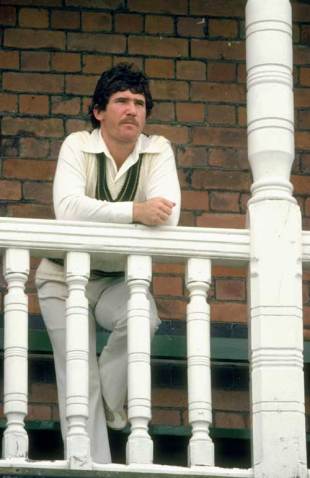Allan Border
The artful stodger
In a team of strugglers and second-stringers, one man stood upright and unsmiling against the tide
Malcolm Knox

Border: a legacy that will grow over the years © Getty Images
| | Enlarge | |
|
When he was playing,
Allan Border was never my favourite cricketer. I couldn't see past the glittering surfaces of Dennis Lillee, Doug Walters, and Ian Chappell; then Vivian Richards, Clive Lloyd and Michael Holding. Experience didn't add depth to my vision. In recent years my favourites have been dashers like Adam Gilchrist, princes of the willow like VVS Laxman, or fearsome athletes like Curtly Ambrose.
But just recently I went back to look at the Australian "Team of the Century", voted in 2000. Every player in the XI was part of a golden age - from the years before the first World War, or playing around Don Bradman in the 1930s and 1940s, or around Chappell in the 1970s, or around Shane Warne and the Waughs in the last decade.
The 12th man in that side played in no great teams. He came into Australian cricket during World Series Cricket. He survived the reunification in 1979 and was building his name as a batsman when Australian cricket disintegrated in 1984. The team were being smashed. Kim Hughes relinquished the captaincy in tears, then fled with a Test squad's worth of players to South Africa.
What did Allan Border do? He had been to the Caribbean, and played
in Trinidad two of the greatest innings by any Australian anywhere: 98 not out and 100 not out, to earn the most miraculous draw. He'd proved himself as the one man who could stand up to them. So he took the captaincy, and in the next few years stood as the single pillar around which Australian cricket was rebuilt. He scored 11,174 Test runs, which no Australian has yet passed. He averaged over 50! He was the only one to make it into that Team of the Century who had spent most of his career surrounded by strugglers.
Also recently, I watched a TV documentary called
Cricket in the Eighties. Usually any sporting footage more than 10 years old looks inferior. Tennis players dab and slice, footballers walk around the park leisurely, cricket's bowlers look round-arm, and the batsmen - even Bradman - have distinctly dodgy techniques. Everything is slower. If you transplanted any player from the past into the present, they simply couldn't take the speed.
Yet when I watched those West Indian batteries - Holding, Malcolm Marshall, Joel Garner, Courtney Walsh, Ambrose - I saw attacks that were faster, nastier, and
harder than today's. Pitches were most certainly quicker and bouncier. If you threw a 2006 vintage Ricky Ponting, or Mohammad Yousuf, or Sachin Tendulkar into a 1984 Test match against those West Indians in, say, Brisbane or Barbados, it's the present stars who would suffer.
| |
|
|
|
| |
| Border retired one year before Australia won back the Frank Worrell Trophy. He never held it. But that's the way life is. It's not a fairytale. And Allan Border was never the fairytale hero |
| |
|
|
|
|
So my appreciation of Allan Border has increased over time. As it should. I feel that Border's legacy will grow and grow over the years, as will Brian Lara's for similar reasons. Yet while Border developed, under duress, personal leadership skills, which Lara never did, he was never as glamorous as the man who took his world record.
Border stood in a baseballer's crouch, bat raised, ready to hop backwards and pull or cut the short ball. The Trinidad innings of 1984 were full of twitching jabs at balls aimed into his armpits. As he aged he became a plainly unattractive batsman to watch, all punch, no grace.
But this is to forget what a wonderful attacker he was. He was arguably the best player of spin Australia has produced in 50 years. He scored 150 in each innings in
a Test in Lahore against Iqbal Qasim and Tauseef Ahmed. It would have been a dream to see him play Shane Warne.
Though his reputation is built on stodge and defiance, Border was also the finest all-round one-day cricketer of his time, alongside Viv Richards. I was at the Sydney Cricket Ground
in 1985 when Border smashed an attack of Holding, Garner, Marshall, Winston Davis and Richards for 127 not out off 140 balls.
He was also a brilliant fielder. In his early years he was a wonderful catcher in the hardest position, the wide third-to-fifth slips.
His left-arm spinners were always useful, and in typical Border fashion, he underused himself. In 1988-89 he took 11 wickets
in a Test match against West Indies.
Yet the enduring image of Border is from off the field, from the decisive
Adelaide Test of the 1992-93 series. Sitting in the dressing room he clutched a lucky cricket ball in his hands. Finally we were going to beat them. Finally Border was going to beat them. Two runs short, Walsh got Craig McDermott with a lifter. The keeper caught the ball, but the cameras caught Border. He sprang to his feet and hurled his ball into the floor. An entire career's worth of frustration captured in a single gesture.
Border retired one year before Australia won back the Frank Worrell Trophy. He never held it. But that's the way life is. It's not a fairytale. And Allan Border was never the fairytale hero. If I'm appreciating him more now, I'm glad. It shows some wisdom is finally getting through.
Malcolm Knox is a former chief cricket correspondent and literary editor of the Sydney Morning Herald
, and the author of six books. This article was first published in the print version of Cricinfo Magazine
in 2007
© ESPN EMEA Ltd.
http://www.espncricinfo.com/magazine...ry/395872.html